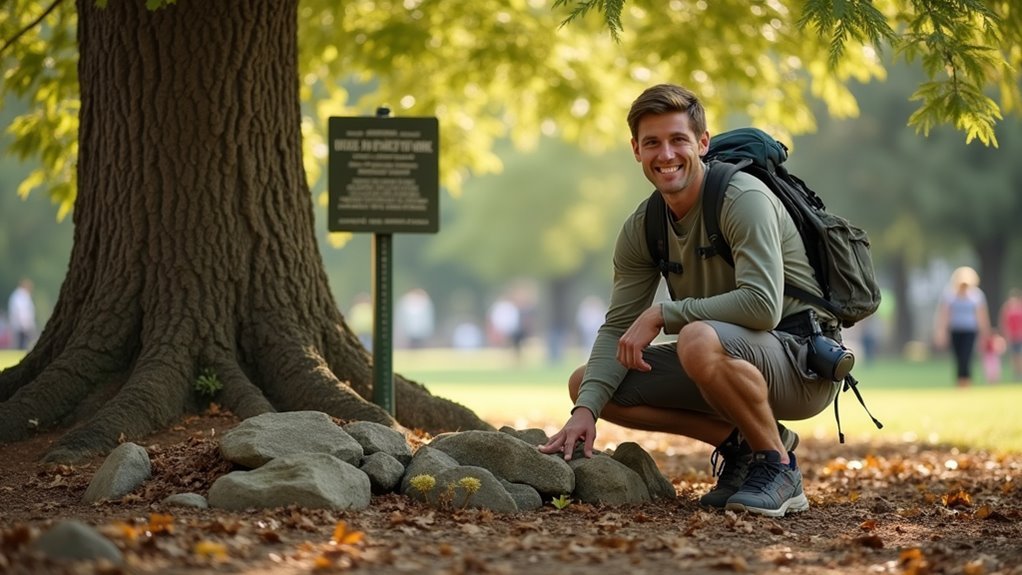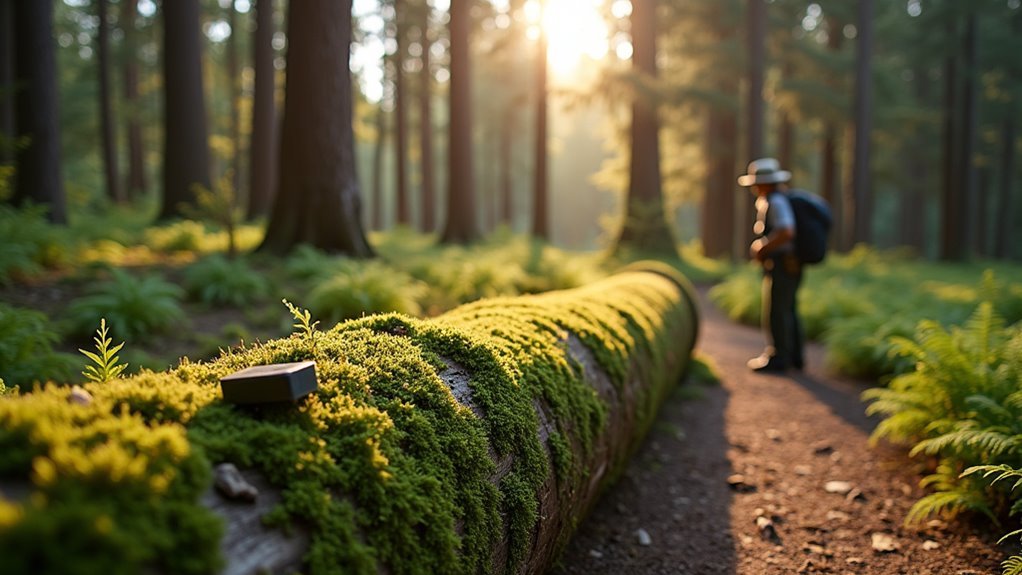Some of the links in this article may be affiliate links. If you make a purchase through these links, we may earn a small commission at no extra cost to you. Thank you.
I bet you didn’t know that nearly 20% of geocache placements get rejected because owners skipped the essential permission step. I’ve learned this lesson the hard way when my carefully crafted container was removed from a local park within days. Getting proper authorization isn’t just about following rules—it’s about respecting property rights and ensuring your cache survives. Before you hide your next treasure, there’s a whole framework of regulations you’ll need to navigate, and I think you’ll be surprised at what’s actually allowed.
Understanding Geocaching Permission Requirements

Securing permission before hiding a cache isn’t just a good practice—it’s absolutely essential.
When you submit a cache page, you’re actually declaring that you’ve already obtained permission from the property owner or manager.
I can’t stress this enough—you bear full responsibility for this step.
For private land, I’d recommend speaking directly with the owner.
Face-to-face is best if possible, but sometimes checking their website works too.
Public areas? Well, that’s where things get a bit trickier.
You’ll need to consult the Regional Geocaching Policies Wiki to identify who manages the land.
Navigating Private Property Placement Rules
Why is accessing private property so complex when it comes to geocache placement? Well, it’s because you’re basically asking permission to invite strangers onto someone else’s land—which, understandably, raises concerns for property owners.
I’ve found that approaching the property owner directly is your best bet.
Direct contact with the property owner almost always yields the best results for geocache permission.
If they’re on-site, have that conversation face-to-face—it builds trust and lets you address any worries immediately.
Can’t meet in person? Check their website for contact details.
Don’t skip getting explicit approval for your exact hiding spot.
I think many cachers make the mistake of securing vague permission, then face removal requests later.
Public Land Regulations and Agency Contacts

I’ve found that identifying the right land manager is often the trickiest part of getting permission for public land caches.
You’ll want to document all communications with agencies, including who you spoke with and when, as proof that you’ve done your homework.
In my experience, reaching out to other local cachers who’ve successfully placed caches on the same property can save you tons of time maneuvering the bureaucratic maze.
Finding Land Managers
How do you actually find who’s in charge of a piece of land where you want to place a geocache? It’s often trickier than you’d expect, but I’ve found a few reliable approaches that work well.
First, I always check the Regional Geocaching Policies Wiki – it’s basically a goldmine for land policies and permit info. When that doesn’t pan out, I turn to search engines or ask nearby cachers.
| Land Type | Where to Look | Who to Contact |
|---|---|---|
| City Park | City website | Parks Department |
| State Park | State DNR site | Park Manager |
| National Park | NPS.gov | Visitor Services |
| County Land | County offices | Land Management |
In my experience, existing geocachers can be your best resource. They’ve already navigated the sometimes confusing world of land managers and permissions.
Permission Documentation Tips
In accordance with public land regulations, documenting your permission for geocache placement isn’t just good practice—it’s often required for approval.
When I communicate with my reviewer, I’ll need solid evidence of permission.
I always record the date, contact person’s name, and specific details about what was approved.
Think of it like building a paper trail—you’ll be glad you have it later!
When approaching land managers, I’ve found it helpful to bring a clear maintenance plan and photos of the container.
This shows I’m serious about responsibility, and honestly, it makes their decision easier.
If you’re not sure who manages a location, don’t guess—reach out to nearby agencies.
They’ll usually point you in the right direction, and that interaction becomes part of your documentation.
Restricted Areas to Avoid When Hiding Caches
Traversing the maze of restricted areas can make or break your geocaching experience.
I’ve learned the hard way that not every cool spot is suitable for hiding a cache.
Before you bury that container (which you shouldn’t do without permission anyway), check the Regional Geocaching Policies Wiki to save yourself future headaches.
When selecting your hiding spot, avoid these common restricted areas:
- Transportation centers – they’re completely off-limits for Event Caches
- Private property where you haven’t gotten explicit permission from the owner
- Areas with limited weekly accessibility – your cache should be available most days
I think the most overlooked rule is about burial.
Even if you’ve got permission to place a cache, digging without specific approval is still a no-go.
Environmental Considerations for Sustainable Cache Placement

When placing your geocache, I always recommend following Leave No Trace principles to protect the natural habitats our community enjoys.
You’ll need to take into account seasonal wildlife concerns, like nesting periods or migration routes, which might temporarily make certain locations off-limits even if they seem perfect year-round.
I’ve learned through experience that the most sustainable cache placements are those that work with nature rather than against it—avoiding sensitive vegetation, staying on established trails, and getting proper permissions before placing anything on public or private land.
Habitat Protection Guidelines
Environmental stewardship should be at the heart of every cache placement you’re considering.
When following Geocache Hiding Guidelines, I’ve learned that respecting natural habitats isn’t just good practice—it’s essential.
Remember, caches buried in soil can damage plant roots and disrupt wildlife burrows, which is why I always recommend surface placements when possible.
Before hiding your cache, make sure you’re not impacting sensitive environments by checking:
- Regional Geocaching Policies Wiki for area-specific restrictions
- Protected habitat designations that might prohibit placements
- Signs of wildlife activity that your cache might disturb
I think the most important thing is maintenance.
If you can’t commit to regularly checking your cache’s environmental impact, you probably shouldn’t place it.
Trust me, a well-placed, eco-friendly cache is much more rewarding than one that damages nature.
Seasonal Wildlife Concerns
The delicate balance between wildlife and geocaching becomes most evident during certain times of the year. When you’re planning to hide the cache, timing is everything! I’ve learned that bird nesting seasons (March-August) are complete no-gos, especially with those Migratory Bird Treaty Act protections in place.
You’ll want to avoid hibernation periods too—from November to March, bears and bats need their beauty sleep without us tramping around.
And don’t get me started on sea turtle nesting season! If you’re in Florida between May and October, keep your caches away from those beaches.
I think the 50-meter buffer zone around wildlife corridors is actually pretty reasonable.
Remember, we’re guests in their home, not the other way around.
Always check local advisories—they’re there for a reason!
Leave No Trace
Respect for nature lies at the heart of every good geocache placement—I can’t stress this enough!
When I hide a cache, I always follow the Leave No Trace principles, which basically means I’m not disrupting the environment.
Think of yourself as a temporary visitor who shouldn’t leave any footprint behind.
Remember these key points when placing your cache:
- Never bury caches without explicit permission from the property owner
- Choose locations that don’t require altering natural features or disturbing wildlife habitats
- Commit to regular maintenance to prevent your cache from becoming environmental litter
I’ve found that the best hiding spots actually use existing features rather than creating new ones.
It’s kind of like being a guest in nature’s home—you wouldn’t rearrange the furniture without asking, right?
Documentation and Record-Keeping for Cache Permissions
Proper documentation of your cache permissions isn’t just a good idea—it’s absolutely essential if you want your cache to remain active.
As cache owners must include specific permission details when submitting to reviewers, I strongly recommend keeping meticulous records of all communications.
In my experience, written evidence like emails from property managers is gold—I learned this the hard way after almost losing a cache placement!
Store these records somewhere you won’t forget; I use a dedicated folder in my email and a physical file at home.
Remember to note dates, names, and exactly what was approved.
Trust me, you’ll thank yourself later if questions ever arise.
I think of permission documentation as insurance—it might seem like a hassle now, but it’s your safety net if challenges come up.
Maintenance Responsibilities and Accessibility Guidelines
Maintaining your geocache isn’t just a one-time effort—it’s an ongoing commitment that I can’t stress enough.
When you place a cache, you’re basically promising the community that you’ll keep it in good condition.
Trust me, I’ve seen how quickly an abandoned cache can become a headache for everyone involved.
Your cache must be:
- Accessible for most of the week (not just weekends or special occasions)
- Located reasonably close to where you live or frequently visit
- Regularly checked for issues like missing logs or damaged containers
I think the biggest mistake new cache owners make is placing caches too far from home.
If your cache is hours away, how will you respond quickly when someone reports a problem?
Working With Land Managers: Effective Communication Strategies
The most critical step in placing your geocache on public or private property is securing proper permission—and that’s where effective communication with land managers comes in.
Seek permission first—your geocaching success depends on clear communication with those who manage the land.
I’ve found that identifying the correct agency first saves tons of time and frustration.
Land policies vary widely, so don’t assume one park’s rules apply everywhere.
In my experience, meeting face-to-face with managers works better than emails.
They appreciate seeing who’s behind the request.
I always bring photos of my container and detailed plans for placement and maintenance.
This level of preparation shows respect for their authority.
Frequently Asked Questions
How to Get Permission to Hide a Geocache?
I’ve searched a mountain of property records to find owners. My negotiation strategies include contacting private landowners directly or researching public land managers through the Regional Geocaching Policies Wiki before requesting placement approval.
What Are the Rules for Hiding Geocaches?
I’ll share key rules: get landowner permission, guarantee accessibility, maintain your cache regularly, minimize environmental impact, use sturdy containers with logbooks, keep it family-friendly, and don’t bury without permission.
Where Can I Hide a Geocache?
You can hide a geocache anywhere you’ve secured proper permission. The thrill of urban exploration awaits, but remember—whether it’s private land or public parks, always get landowner approval before placing your cache.
Do You Need Permission to Place a Geocache?
Yes, you absolutely need permission. I always secure approval before placing caches as part of geocaching’s Permission Ethics. It’s your responsibility whether it’s private land or public property.